Access control devices advance for health care

Image courtesy of Siemens Smart Infrastructure USA
Hospitals pose many challenges to manufacturers of access control equipment and devices. All health care facilities are different, especially when it comes to security. Not only do access control systems need to keep restricted areas secure, but they also need to grant access to authorized personnel in a simple yet secure manner without negatively affecting the patient experience.
Also, the need to protect health information must be balanced with quick access by authorized personnel, and access control solutions must adhere to HIPAA guidelines. As hospitals consolidate and expand through acquisition, the management of disparate card access credentials and key fobs poses a challenge as well.
Connectivity a factor
The good news for hospital facilities managers is that access control technology has evolved in recent years, with connectivity being a major factor.
Genetec Inc., Montreal, Canada, continues to advance its Genetec Security Center Synergis solution with capabilities that address the evolving challenges facing hospitals, according to John Joyce, director of sales for enterprise markets. These upgrades include providing granular control over who has access to facilities, reducing tailgating and improper use of physical credentials and cards, requiring two-person access to high-security areas and responding to threats in real-time, instantly locking down areas or an entire facility.
“Moving to the cloud makes it easier to modernize older access control systems,” Joyce says. “Being able to centrally manage access rights and automate manual processes provides a more fluid experience and offers continuous access to important cybersecurity updates and product enhancements.”
As in most fields, hospitals are looking to connected technologies or digital devices to manage security and access control, according to Dave Stolerow, national business manager for smart building security products and services at Siemens Smart Infrastructure USA, Buffalo Grove, Ill. “In fact, most devices being installed throughout hospitals are now connected in a digital form. In addition to security devices, we see building and room systems and controls installed with connected devices,” he says.
Siemens recently introduced its Security Manager through Building X, an open and cloud-based platform that allows multiple systems to be connected and managed through a single user experience. “Security Manager provides an executive-level overview of the security systems, alarms and events, as well as health status with dashboards and reporting functionality,” Stolerow says. “Access control is managed from the interface with integrations to video for visual verification of alarms.”
Johnson Controls, Milwaukee, has introduced C•CURE IQ Security Intelligence, a dashboard designed to reshape the security landscape by amplifying security acumen and spatial optimization. One of its key features is “alarm intelligence” for alarm noise reduction, which sieves out irrelevant alarms, ensuring that security teams are only summoned for real threats. Another feature, “spatial intelligence,” harnesses the power of data-driven insights to provide a deep understanding of facility utilization.
“Going beyond just a monitoring system, spatial intelligence secures personnel while maximizing resource usage,” says Rick Focke, director of product management, security products, for building technologies and solutions at Johnson Controls. “It enables real-time insights to where people are located during emergencies and how the facility’s space is used in conjunction with human interaction.”
Evolving technology
“Connectivity is a major factor as internet protocol technologies allow for seamless, remote operation,” agrees Matt Kjin, health care segment development manager for Axis Communications, Chelmsford, Mass. “Network access control solutions are being combined with other security solutions such as intercoms, cameras and sensors, allowing for interoperability between devices and bolstering security in health care environments.”
Access control devices that stay clean or protect against bacteria have become a recent priority in hospitals, adds Matt Welty, vice president for the Americas at Codelocks, Rancho Cucamonga, Calif. “Our company’s Clean by Codelocks is an optional, clear-coated finish that combats SARS-Cov-2 coronavirus and can reduce bacterial growth by 99.96%, providing an additional measure of protection over sanitization,” he says.
Skip Burnham, national sales manager at Dortronics Systems Inc., Sag Harbor, N.Y., has seen a sharp increase in demand for compact electronic locks to secure drawers and cabinets, specifically for examination rooms and pharmacies where supplies may have been left unattended by personnel.
“Theft of supplies and products seems to be on the rise in health care facilities,” Burnham says. “This is easily preventable by using these devices.” One such device is Dortronics’ MM-300 electromagnetic lock, which is suitable for cabinets and drawers. “It has 300 pounds of direct holding force, fail-safe operation, and it can be controlled individually or simultaneously from one or several locations,” he adds.
Smaller, off-campus health care facilities pose their own set of challenges for access control equipment and devices.
A blend of technology is required at these smaller facilities, depending on the functionality needed at each door and what works best within the existing infrastructure, according to Tom Morgan, director of business development for health care at Assa Abloy Door Security Solutions, New Haven, Conn. “In fact, we’re experiencing growth across our complete range of access control solutions at these smaller facilities, from electric strikes and magnetic locks to integrated wireless locks, because they offer an efficient way to expand the access control footprint in any facility,” he says.
Access control products for smaller facilities need to be price-sensitive because they are not part of a large hospital infrastructure. But they also need to be scalable into the existing architecture so credentials can be used in all buildings in the health care portfolio, according to Melany Whalin Sr., senior demand creation manager for health care and education at Allegion, Carmel, Ind. “Some of these needs are being met by offering medium and high price-point products that have different features but the same Internet of Things backbone, so they can work at both locations,” says Whalin.
Other innovations
The latest access control equipment and devices include door controllers, electromagnetic locks, visitor management systems, optical turnstiles, electronic keyways and intelligent keys, and access control platforms.
Access control systems that use lightweight directory access protocol for personnel updates and visitor management can help control the wide range of nonpatient, visitor and employee populations in hospitals, according to Mark Evans, executive vice president at Sielox LLC, Runnemede, N.J. His company offers the Pinnacle access control platform and system cleanup tool, which confirms that old data and settings are eliminated.
“Hospitals can enhance safety and security by removing duplicate, expired and inactive cardholders,” Evans says. “Also, mobile credentials become another security layer via touchless access control.”
Axis Communications offers Axis Powered by Genetec, which combines Axis A1610 and A1210 Network Door Controllers with Genetec’s Synergis access control software into an all-in-one solution that provides easy deployment, maintenance and scalability. “The door controllers are united with Synergis via the Axis camera application platform to enable real-time monitoring of events and alarms, advanced cardholder and access management, and comprehensive reporting,” Kjin says.
Codelocks has introduced several KitLock products that are applicable to the health care market. “Our KL1100 is available in both a radio-frequency identification and a keypad configuration,” Welty says. “Both feature a powered latch with intuitive push-shut closing and a front controller plate that incorporates a continuous surface that is easily cleaned and does not have recesses for dirt and germs to gather. The KL1000 G3 incorporates these features along with a mechanical key override and batteries that can be changed from the front of the lock.”
At their main entrances, hospitals are increasingly specifying and requiring products that not only restrict access to authorized personnel but also detect, monitor and prevent unauthorized users from entering by tailgating. Optical turnstiles are commonly deployed for employee and designated personnel access only, according to Nick Simon, national security sales manager at Alvarado dormakaba Group, North America, Chino, Calif.
Alvarado dormakaba Group recently introduced the Argus V60 Swinging Barrier Optical Turnstile. “The V60 offers the most compact cabinet in the industry while providing the same level of tailgate detection seen in much deeper form factors,” Simon says. “The V60 can fit in areas where other turnstiles do not — allowing health care facilities to achieve the security level they need throughout their space.”
Many hospitals are updating door security by re-keying openings with electronic keyways, or “eCylinders,” and intelligent keys, according to Morgan at Assa Abloy Door Security Solutions. “These easy retrofit solutions look and install like a simple mechanical lock but add a practical level of electronic access control to existing doors. Wireless access control solutions such as our HES K100 Aperio wireless cabinet lock provide hospitals with the freedom to focus on patient health and safety, offering the accountability, convenience and security needed to operate efficiently.
“In the area of key control and openings management platforms, more hospitals are using programs such as our SimpleK for key management and Openings Studio to capture and tag door assets that can generate a database for managing maintenance and repairs and to help design, visualize and specify components for future openings,” Morgan adds.
Allegion has introduced the Stanley Access Technologies ProCare 8500 telescopic intensive care unit (ICU) door, which is designed to create a wide door opening at more than 56-inch clearance for a manual 8-foot telescoping, three-panel ICU door, according to Whalin. It comes in manual or fully automatic models with the option of power assist.
Allegion also offers the LCN 6400 Compact Series automatic door operator, which allows hospitals to keep their existing LCN closer and convert it to an automatic operator for touchless and Americans with Disabilities Act (ADA)-compliant applications. “It’s less expensive than removing the existing closer and buying a whole new automatic operator,” Whalin says.
Many real-time location system (RTLS)-based devices and related technologies are gaining traction in health care, according to Clete Bordeuax, health care business development director of identity and access management solutions at HID, Austin, Texas. Duress badge holders and wearable fobs from HID feature a discreet button that, when pushed, activates emergency protocols as defined by the organization without anyone in the room knowing that help has been summoned. An alert is sent to the cloud through connected gateways.
HID also offers patient-management devices that are worn around the wrist and used alongside the duress-alerting badge holders worn by hospital staff. “The wristbands identify patients and support RTLS applications, extending situational awareness across the entire building while streamlining patient admissions through discharge,” Bordeuax says.
Finally, Securitech Group Inc., Maspeth, N.Y., has introduced the Solis ligature-resistant lockset, which includes electric release options. “Solis was designed to aesthetically meet behavioral health care needs while providing a closed-back lever that is ADA-compliant,” says Mark Berger, general manager. “A new ligature-resistant pushbutton and mechanical indicator were recently introduced for restrooms to lock and indicate occupancy.”
Looking ahead
Vendors predict that the use of mobile credentials will continue to increase. Also, they expect an influx of artificial intelligence that will combine video and access control, resulting in smarter systems.

SECURE SERVICE
Security Center Synergis delivers operational and critical insights on secured areas in hospitals. Genetec Inc.

ALL ACCESS
The Security Manager application can help identify, manage and control varying access levels to different areas of hospitals. Siemens Smart Infrastructure USA
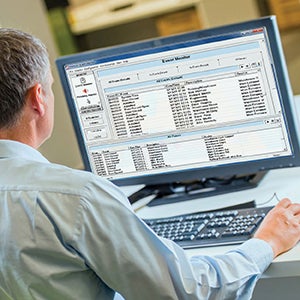
AUTHORIZED ACCESS
The Pinnacle advanced access control solution ensures that only authorized individuals can access restricted areas, information or assets. Sielox LLC
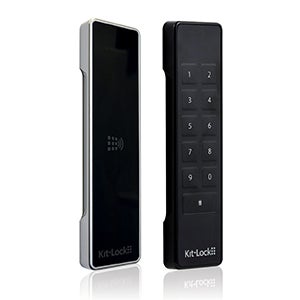
MANAGEABLE SOLUTION
The KL1100 radio-frequency identification and keypad can be managed locally or remotely, allowing hospitals to easily configure individual or groups of locks. Codelocks
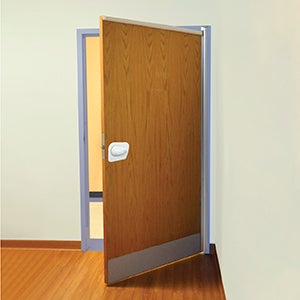
SAFETY FIRST
The Solis ligature-resistant lever provides an attractive solution for behavioral facilities. Securitech Group Inc.
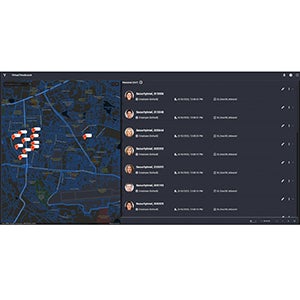
SMART SOLUTION
C•CURE IQ Security Intelligence provides real‑time, graphical cardholder location tracking to improve employee safety. Johnson Controls
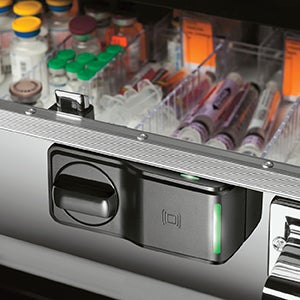
WIRELESS WONDER
Wireless access control solutions such as the HES K100 Aperio wireless cabinet lock offer hospitals accountability, convenience and security. Assa Abloy Door Security Solutions
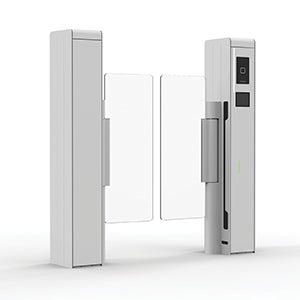
CAREFUL EYE
The compact Alvarado Argus V60 optical turnstile is designed for use where safety and security are needed and space is limited. Alvarado dormakaba Group
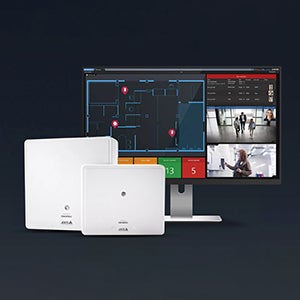
COMPLETE CONTROL
Axis Powered by Genetec combines Axis network door controllers and Genetec access control software. Axis Communications
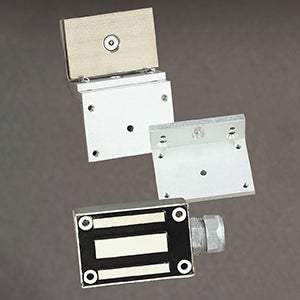
SECURE STORAGE
Suitable for cabinets and drawers, the MM‑300 electromagnetic lock features 300-pound direct-holding force and fail-safe operation. Dortronics Systems Inc.
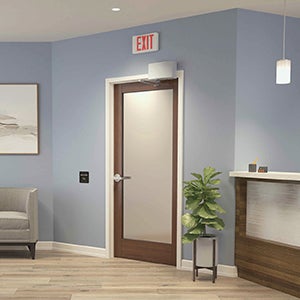
NO TOUCH
The LCN 6400 Compact Series automatic door operator allows hospitals to keep their LCN closer and convert it to an automatic operator for touchless and Americans with Disabilities Act‑compliant applications. Allegion
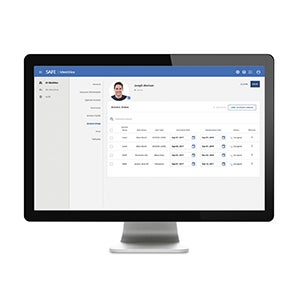
SIMPLIFIED SECURITY
Physical Identity and Access Management simplifies management of access control systems by providing a single portal or user interface. HID
Neal Lorenzi is a Mundelein, Ill.-based contributor to Health Facilities Management.




